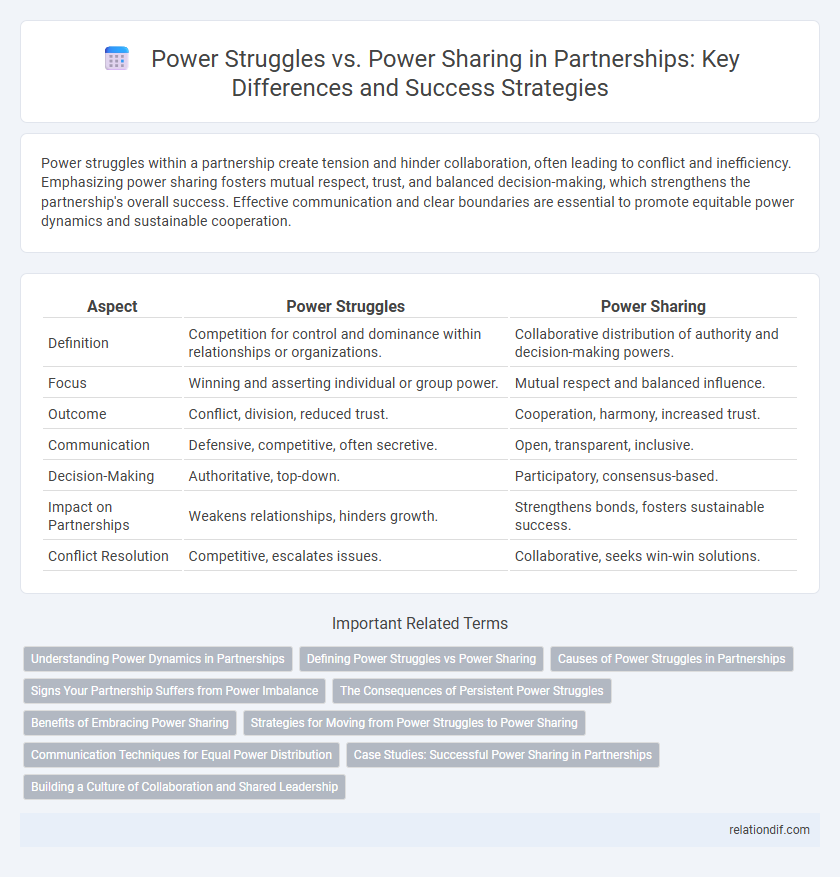Power struggles within a partnership create tension and hinder collaboration, often leading to conflict and inefficiency. Emphasizing power sharing fosters mutual respect, trust, and balanced decision-making, which strengthens the partnership's overall success. Effective communication and clear boundaries are essential to promote equitable power dynamics and sustainable cooperation.
Table of Comparison
| Aspect | Power Struggles | Power Sharing |
|---|---|---|
| Definition | Competition for control and dominance within relationships or organizations. | Collaborative distribution of authority and decision-making powers. |
| Focus | Winning and asserting individual or group power. | Mutual respect and balanced influence. |
| Outcome | Conflict, division, reduced trust. | Cooperation, harmony, increased trust. |
| Communication | Defensive, competitive, often secretive. | Open, transparent, inclusive. |
| Decision-Making | Authoritative, top-down. | Participatory, consensus-based. |
| Impact on Partnerships | Weakens relationships, hinders growth. | Strengthens bonds, fosters sustainable success. |
| Conflict Resolution | Competitive, escalates issues. | Collaborative, seeks win-win solutions. |
Understanding Power Dynamics in Partnerships
Power struggles in partnerships often stem from imbalanced authority and unclear roles, leading to conflicts that hinder collaboration. Understanding power dynamics requires recognizing each partner's influence, communication styles, and decision-making preferences to foster equitable involvement. Effective power sharing enhances trust, promotes mutual respect, and drives sustainable success in joint ventures.
Defining Power Struggles vs Power Sharing
Power struggles involve competing interests where parties vie for control, often resulting in conflict and deadlock. Power sharing distributes authority and decision-making among partners, fostering collaboration and mutual respect. Defining these concepts clarifies dynamics in partnerships and guides effective conflict resolution.
Causes of Power Struggles in Partnerships
Power struggles in partnerships often stem from unclear roles, conflicting goals, and imbalance in decision-making authority. When partners lack transparent communication and mutual trust, competition for control intensifies, leading to conflict and reduced collaboration. Addressing these root causes through defined responsibilities and shared leadership can mitigate power tensions and enhance partnership effectiveness.
Signs Your Partnership Suffers from Power Imbalance
A partnership exhibiting power imbalance often displays signs such as one partner consistently dominating decision-making and dismissing the other's input, leading to feelings of resentment and decreased collaboration. Frequent conflicts, lack of mutual respect, and unequal distribution of responsibilities indicate a struggle for control rather than cooperative power sharing. Recognizing these patterns early allows for constructive dialogue and reestablishing equitable partnerships that foster trust and joint success.
The Consequences of Persistent Power Struggles
Persistent power struggles in partnerships often lead to erosion of trust, increased conflict, and decreased collaboration, significantly undermining shared goals. These struggles can cause emotional exhaustion and decision-making paralysis, reducing overall productivity and innovation. Long-term consequences include diminished organizational culture and potential dissolution of the partnership due to unresolved tensions.
Benefits of Embracing Power Sharing
Embracing power sharing in partnerships fosters collaboration, enhances mutual trust, and drives collective decision-making that benefits all parties involved. Power sharing reduces conflicts by balancing influence and encouraging open communication, resulting in more sustainable and effective outcomes. This cooperative approach promotes innovation and leverages diverse perspectives, ultimately strengthening the partnership's resilience and long-term success.
Strategies for Moving from Power Struggles to Power Sharing
Effective strategies for moving from power struggles to power sharing include fostering transparent communication, establishing clear roles and responsibilities, and building mutual trust among partners. Implementing collaborative decision-making processes and encouraging active listening helps to reduce conflicts and promote equitable influence. Emphasizing shared goals and interdependence strengthens commitment to partnership success and collective problem-solving.
Communication Techniques for Equal Power Distribution
Effective communication techniques for power sharing emphasize active listening, empathy, and transparent dialogue to balance authority among partners. Utilizing nonviolent language and framing discussions around mutual goals reduces conflict and fosters trust. Establishing clear communication protocols ensures all voices are heard, promoting equitable decision-making and minimizing power struggles.
Case Studies: Successful Power Sharing in Partnerships
Case studies of successful power sharing in partnerships highlight equitable decision-making frameworks that foster trust, transparency, and mutual respect. Companies like Ben & Jerry's and Patagonia demonstrate how shared leadership roles and collaborative conflict resolution lead to sustained innovation and growth. These models emphasize balanced influence distribution, ensuring all partners contribute their expertise and share accountability for outcomes.
Building a Culture of Collaboration and Shared Leadership
Power struggles undermine trust and hinder effective decision-making, whereas power sharing cultivates a culture of collaboration and mutual respect. Emphasizing shared leadership encourages diverse perspectives, fosters innovation, and strengthens organizational resilience. Establishing transparent communication and equitable responsibility distribution is essential for sustaining long-term partnership success.
Power Struggles vs Power Sharing Infographic

 relationdif.com
relationdif.com